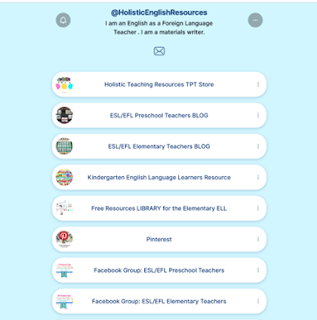Link to the Adjectives resource is here for your lesson planning :
https://www.teacherspayteachers.com/Product/Adjectives-for-Elementary-ELL-2150071
The adjectives small cards take up little space and can be grouped in envelopes, zip bags, or boxes by theme or adjective category. They are great for fast-paced games, pair work, or last-minute review. Easy to pull out for warm-ups, transitions, or group stations.
Describe
the Face! – 26 Face Cards for Teaching Physical Appearance Adjectives.
This
is a set of 26 face cards for practicing adjectives related to hair, eyes.
Each
card has a name and a number for identification and game purposes.
These cards give learners a real reason to speak and are great for adjective + noun sentence structure practice.
Teacher:
Mandy has long straight red hair and brown eyes.
Develop speaking, listening, and reading skills. Reinforce adjective + noun and "has/has got" grammar structures. Describe and Find
Teacher:
he has red hair and blue eyes!
Students:
He is number 6. He is Tim!
Play Guess Who? Place all the cards on the board. A student can give clues while classmates ask yes/no questions to identify the character.
"Is it a boy?" "Does he have curly
hair?"
Place these two flashcards on a small board to present the order of the adjectives to describe the hair. Use a different marker or chalk for each set of words. Point to both hair and ask questions.
Teacher:
Look at Kelly. What color is her hair?
Student:
black. The teacher writes the word
black. Do the same for Felicia.
Teacher:
Look at Felicia. Her hair is long. The
teacher writes the word long and trace her long hair. Do the same for Kelly.
Teacher:
Look at Kelly. Her hair is curly. The
teacher writes the word curly and trace her curly hair. Do the same for
Felicia.
Describe
Kelly’s hair and then have the students describe Felicia’s. Remember the order:
length, type of hair, color.
Teacher:
Kelly has short curly black hair.
Teacher:
Felicia has long straight blonde hair.
Graph the students in class.
Have
the students ask questions to their classmates using the card.
Then make a big graph on the board using the flashcards.
Here are flashcards with whole body. Play a Sorting Game
Students
sort the cards by hair color, hair length, and hair type.
Play Adjective Hunt.
Give
students a list of people from the grid. They must find and point to cards that
match each one.
"Find someone with long green hair."
Student:
That’s A5
Choose and write. Students choose a card and write a short description. Then, one student reads a description aloud. Others must guess the name or number from the card. Great for listening practice.
Then,
have the students sort those cards according to the hair description.
Bingo or Matching. Have the students sort the cards into tall or short people. Then, students write 8 numbers of people on their bingo board on their notebooks.
Call
out traits (He is fat. He has black hair.) and have students find matching
cards on their Bingo grid or mat.
This resource has more to check, go to this blog post:https://eflelementaryresources.blogspot.com/2025/06/adjectives-worksheets-and-printable-book.html
Visit my TPT Store: Holistic English Resources by Rosa Amelia.
Find creative, hands-on activities and worksheets to make your lessons both
enjoyable and effective.
https://www.teacherspayteachers.com/Store/Holistic-English-Resources-By-Rosa-Amelia







.png)














































